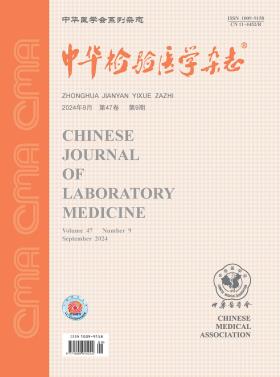Clinical utility value of urinary aldosterone detection by tandem mass spectrometry in primary hyperaldosteronism screening
Q4 Health Professions
引用次数: 1
Abstract
Objective To explore the clinical utility of liquid chromatography tandem mass spectrometry forprimary aldosteronism screening. Methods From January to October 2019, 413 inpatients diagnosed hypertension from Fuwai Hospital of Chinese Academy of Medical Sciences were enrolled, including 60 Primary aldosteronism(PA)patients and 353 primary hypertension patients. The plasma aldosterone concentration (PAC) and renin concentration (DRC) were measured after 2 h of standing. The 24 h urine samples were collected for measurement of aldosterone using LC-MS/MS. The performance of urine aldosterone and urine aldosterone/renin ratio (UADRR) in PA screening was evaluated by ROC, and compared with PAC/DRC ratio (ADRR). Meanwhile, the efficiency of urine aldosterone in elderly patients or patients with low blood potassium or 24 h urine sodium over 200 mmol was investigated. Results Area under the curve (AUC)of urine aldosterone was 0.725 (95%CI 0.679-0.767), and the best cut-off was 7.13 μg/24 h, which was lower than AUC of ADRR (0.958, 95%CI 0.934-0.975). The AUC of UADRR was 0.947 (95%CI 0.920-0.966), the best cut-off was 1.11 (μg/24 h)/(μIU/ml), the sensitivity and specificity were 91.7% and 89.0%, respectively. There is no significant differences found with ADRR. In patients with 24 h urine sodium over 200 mmol, AUC of aldosterone was 0.834 (95%CI 0.730-0.910) and the best cut-off was 9.31 μg/24 h. The sensitivity and specificity were 90.9% and 68.7%, respectively. For the elderly patients over 60 years old, the AUC of urinary aldosterone was 0.860 (95%CI 0.770-0.925), and the best cut-off was 6.91 μg/24 h. The sensitivity and specificity were 84.6% and 81.3%, respectively. When admission blood potassium was less than 3.50 mmol/L, AUC of urinary aldosterone was 0.822 (95%CI 0.684-0.917), and the best cut-off was 10.63 μg/24 h. The sensitivity and specificity were 85.7% and 66.7%, respectively. Conclusion The detection of aldosterone in urine by LC-MS/MS can provide clinical information for PA screening, and the screening performance is better in patients with 24-hour urine sodium over 200 mmol, elderly patients or patients with low blood potassium. If combined with renin, screening efficiency was the same as that in ADRR. Key words: Hyperaldosteronism; Aldosterone; Urinalysis; Tandem mass spectrometry; Chromatography, liquid串联质谱法检测尿醛固酮在原发性高醛固酮症筛查中的临床应用价值
目的探讨液相色谱串联质谱法筛查原发性醛固酮增多症的临床应用价值。方法选取2019年1 - 10月中国医学科学院阜外医院高血压住院患者413例,其中原发性醛固酮增多症(PA)患者60例,原发性高血压患者353例。静置2 h后测定血浆醛固酮浓度(PAC)和肾素浓度(DRC)。取24 h尿样,采用LC-MS/MS法测定醛固酮含量。采用ROC法评价尿醛固酮和尿醛固酮/肾素比值(UADRR)在PA筛查中的表现,并与PAC/DRC比值(ADRR)进行比较。同时,对老年患者、低血钾患者或24 h尿钠超过200 mmol患者的尿醛固酮效率进行了研究。结果尿醛固酮的曲线下面积(AUC)为0.725 (95%CI 0.679 ~ 0.767),最佳临界值为7.13 μg/24 h,低于adr的AUC (0.958, 95%CI 0.934 ~ 0.975)。UADRR的AUC为0.947 (95%CI 0.920 ~ 0.966),最佳截止值为1.11 (μg/24 h)/(μIU/ml),灵敏度为91.7%,特异性为89.0%。在不良反应发生率方面没有发现显著差异。24 h尿钠≥200 mmol的患者醛固酮AUC为0.834 (95%CI 0.730 ~ 0.910),最佳临界值为9.31 μg/24 h,敏感性为90.9%,特异性为68.7%。60岁以上老年患者尿醛固酮AUC为0.860 (95%CI 0.770 ~ 0.925),最佳临界值为6.91 μg/24 h,敏感性为84.6%,特异性为81.3%。入院血钾< 3.50 mmol/L时,尿醛固酮AUC为0.822 (95%CI 0.684 ~ 0.917),最佳临界值为10.63 μg/24 h,敏感性为85.7%,特异性为66.7%。结论LC-MS/MS检测尿醛固酮可为PA筛查提供临床信息,且24小时尿钠≥200 mmol、老年患者及低血钾患者筛查效果较好。如果联合肾素,筛选效率与ADRR相同。关键词:高醛固酮增多症;醛固酮;验尿;串联质谱法;色谱法、液体
本文章由计算机程序翻译,如有差异,请以英文原文为准。
求助全文
约1分钟内获得全文
求助全文
来源期刊

中华检验医学杂志
Health Professions-Medical Laboratory Technology
CiteScore
0.40
自引率
0.00%
发文量
8037
期刊介绍:
 求助内容:
求助内容: 应助结果提醒方式:
应助结果提醒方式:


